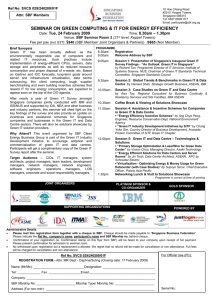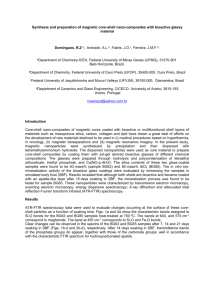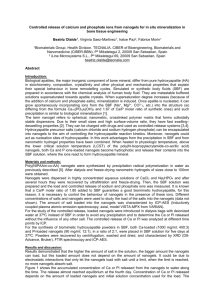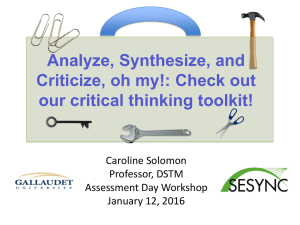The SBF survey of galaxy distances - J.L. Tonry file:///e:/moe/HTML/March02/Tonry/paper.html#Figure%204
advertisement
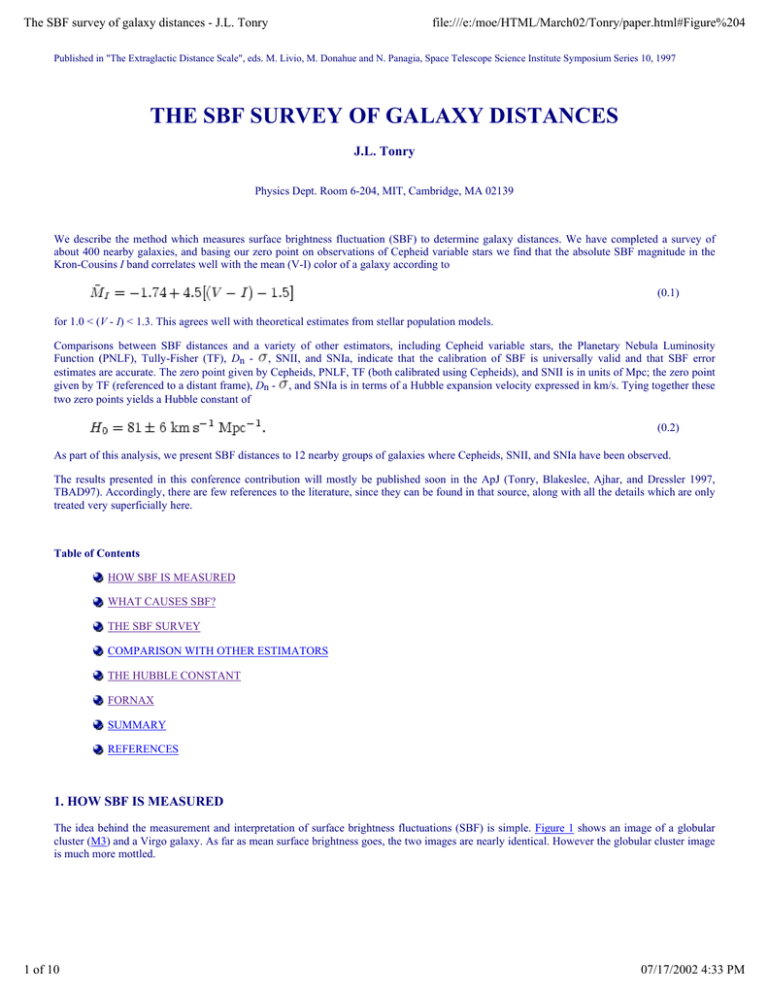
The SBF survey of galaxy distances - J.L. Tonry file:///e:/moe/HTML/March02/Tonry/paper.html#Figure%204 Published in "The Extraglactic Distance Scale", eds. M. Livio, M. Donahue and N. Panagia, Space Telescope Science Institute Symposium Series 10, 1997 THE SBF SURVEY OF GALAXY DISTANCES J.L. Tonry Physics Dept. Room 6-204, MIT, Cambridge, MA 02139 We describe the method which measures surface brightness fluctuation (SBF) to determine galaxy distances. We have completed a survey of about 400 nearby galaxies, and basing our zero point on observations of Cepheid variable stars we find that the absolute SBF magnitude in the Kron-Cousins I band correlates well with the mean (V-I) color of a galaxy according to (0.1) for 1.0 < (V - I) < 1.3. This agrees well with theoretical estimates from stellar population models. Comparisons between SBF distances and a variety of other estimators, including Cepheid variable stars, the Planetary Nebula Luminosity Function (PNLF), Tully-Fisher (TF), Dn - , SNII, and SNIa, indicate that the calibration of SBF is universally valid and that SBF error estimates are accurate. The zero point given by Cepheids, PNLF, TF (both calibrated using Cepheids), and SNII is in units of Mpc; the zero point given by TF (referenced to a distant frame), Dn - , and SNIa is in terms of a Hubble expansion velocity expressed in km/s. Tying together these two zero points yields a Hubble constant of (0.2) As part of this analysis, we present SBF distances to 12 nearby groups of galaxies where Cepheids, SNII, and SNIa have been observed. The results presented in this conference contribution will mostly be published soon in the ApJ (Tonry, Blakeslee, Ajhar, and Dressler 1997, TBAD97). Accordingly, there are few references to the literature, since they can be found in that source, along with all the details which are only treated very superficially here. Table of Contents HOW SBF IS MEASURED WHAT CAUSES SBF? THE SBF SURVEY COMPARISON WITH OTHER ESTIMATORS THE HUBBLE CONSTANT FORNAX SUMMARY REFERENCES 1. HOW SBF IS MEASURED The idea behind the measurement and interpretation of surface brightness fluctuations (SBF) is simple. Figure 1 shows an image of a globular cluster (M3) and a Virgo galaxy. As far as mean surface brightness goes, the two images are nearly identical. However the globular cluster image is much more mottled. 1 of 10 07/17/2002 4:33 PM The SBF survey of galaxy distances - J.L. Tonry file:///e:/moe/HTML/March02/Tonry/paper.html#Figure%204 Figure 1. Images of the GC M3 and the galaxy N4472. Setting aside the technical difficulties, the measurement of SBF is straightforward: 1. Pick a patch of galaxy. 2. Measure the pixel-to-pixel rms: 3. Measure the average flux: g. . The flux that we see in a pixel is coming from a finite number N of stars of average flux , and so we expect that g = N , and = N1/2 , so 2 as = / g. For example, at a radius of 1 arcmin in the bulge of M31 we might see an I surface we can solve for this average flux brightness of g = 16 mag sec-2. Assuming we're in the limit of no readout noise and perfect seeing so that adjacent pixels are negligibly blurred with each other (see below how to deal with the true situation), we might find that the irreduceable mottling in 1" pixels gives = 19.5 mag, i.e. about 4 percent of the mean brightness. We can then immediately solve for the magnitude corresponding to as I = 2×19.5 - 16.0 = 23.0 mag. There are, of course, technical difficulties. The first is that seeing blurs pixels together, reducing the from what it would be at the top of the atmosphere, with only Poisson statistics operating. Since we know accurately what the point spread function (psf) is from stars in the field, we can compensate for this effect and compute what , would be in the absence of seeing. Our method is to do this in the Fourier domain, where convolution by the psf becomes multiplication by the transform of the psf. A second challenge is that there are other sources of noise. We have some detector readout noise, and there is noise from the Poisson statistics of the photons collected as well as the Poisson noise from the finite number of stars. In our method we exploit the fact that these sources of noise are not blurred by the psf and therefore have a white noise spatial power spectrum. Figure 2 illustrates schematically what the power spectrum looks like. Figure 2. A schematic drawing of the SBF power spectrum. Galaxies can also be bumpy if the stars are correlated with each other, either through their own gravity, or more likely from the gravity perturbations from a large-scale mode. Spiral arms are an example of this, and the SBF method is not applicable in such situations. However, in "hot" stellar systems, elliptical galaxies and the bulges of S0 and spiral galaxies, the scale length for such correlations is many kpc, and they produce negligible power at the pixel sizes of 20 pc. Another problem is the mottling produced by dust. We have done experiments in the bulges of M31 and M81, where we identify the dust in the B band and then measure SBF in the I band, in regions where the dust appears to be negligible as well as regions where the dust is prominent. We find that the SBF measurement is quite robust in the presence of these weak (< 10 percent) dust features, both because the dust absorption is much less in the I band, and also because the dust has a spatial power spectrum which is mostly at lower frequencies than where we fit for . 2 of 10 07/17/2002 4:33 PM The SBF survey of galaxy distances - J.L. Tonry file:///e:/moe/HTML/March02/Tonry/paper.html#Figure%204 Figure 3. A schematic cut through a galaxy image, showing noise and point sources (left), and the resulting luminosity function of the point sources (right). The most serious problem is the removal of "point sources", i.e. foreground stars, globular clusters, and background galaxies which appear in an image. We accomplish this by using DoPhot to identify them to some completeness limit, fitting the resulting luminosity function, deleting the sources brighter than some completeness limit, and estimating the residual variance left in the image by integrating an extrapolation of our luminosity function beyond the completeness limit. This is the fundamental distance limitation to SBF, since the delectability of point sources drops radically with distance at a fixed seeing, and this compensation for residual variance is relatively uncertain. The bottom line is that the minimal requirements for an SBF measurement are: Object: clean (low dust) E / S0 / spiral bulge 2 Signal: Seeing: > 5(gxy + sky + readnoise), i.e. > 5 photon / . -1 psf < 1.0" (d / (2000 km s )) (I band) with and error of about 0.2 mag. If you improve both by a factor of two, the error will Such minimal exposure and psf should give a reliable drop to about 0.1 mag, but further improvement is slowed by systematics of flattening, color terms, etc. 2. WHAT CAUSES SBF? The interpretation of what we are seeing is straightforward. The portion of a galaxy projecting onto a pixel might have ni stars of luminosity Li (Figure 4). Figure 4. An HR diagram, showing a contributor to the SBF sum. Over many samples, Poisson statistics imply that each star contributes a luminosity variance of Li2, so the total luminosity variance is 2 Li . The mean total luminosity within the pixel is just g = divided by the first: 2 = ni niLi, so we are therefore measuring the second moment of the luminosity function (2.3) varies as a function of color, and depends on stellar population. It is therefore not a perfect "standard candle" (although its total range of variation is much less than most objects which are called standard candles!), but it does vary in a predictable way. We have concentrated on the I band because the original models we calculated using the Revised Yale Isochrones indicated that: 3 of 10 07/17/2002 4:33 PM The SBF survey of galaxy distances - J.L. Tonry file:///e:/moe/HTML/March02/Tonry/paper.html#Figure%204 1. is the brightest in the optical. 2. Age, metallicity, IMF are degenerate, and is nearly a one-parameter family. 3. has a very small scatter with respect to its trend with (V - I). 4. has a very small overall variation with population. Worthey has subsequently computed better models which confirm items 1-3 above, but we have found that the slope of I is steeper than we had thought, with a total change of about 1 mag over the full range of early-type galaxy stellar population. His models are illustrated in Figure 5. Note how the age and metallicity are degenerate in the optical, but become distinct in the IR. Figure 5. SBF luminosity derived from theoretical models (left) and a blowup of how SBF depends on metallicity and age in the IR. There is an abrupt change in the behavior of in the IR, which arises because the stars at the tip of the RGB, which have the highest bolometric luminosity, are shrouded in the optical and have a lower flux in the optical than stars lower down the RGB. The IR is potentially better for SBF but 1. 2. 3. 4. More sensitive to AGB (needs work), Sky is much brighter (not in outer space, though), Detectors are worse (but catching up fast), Metallicity and age become non-degenerate. To summarize the SBF method then, the measurement is repeatable and perfectible. Given a suitable system and sufficient photons, resolution, and calibration, it is possible to measure to arbitrary accuracy, certainly better than 10 percent. The interpretation also has a solid foundation. Models of stellar populations depend on metallicity, age, IMF, post-RGB evolution, etc. The constraints we can measure include distance independent quantities such as colors, fluctuation colors, and line strengths. If the distance is known, we can add to this list fluctuation absolute magnitudes as well. The models and constraints meet in a library of isochrones which are combined to form a luminosity function and spectral energy distribution. Integration of the SED yields . Both empirical and theoretical work in the I band at least indicates that I can be constrained to 0.05 mag by measurement of just the (V - I) color. 3. THE SBF SURVEY We (Ed Ajhar, John Blakeslee, Alan Dressler, myself, and many friends) have been carrying out a survey of SBF of nearby galaxies in order to determine their distances. It has taken over five years, because we had to refigure the MDM 2.4-m optics (thanks to Paul Schechter), build CCD cameras (thanks to Gerry Luppino and Mark Metzger), and redo the computers and telescope control system (thanks to Mark Metzger) before we could carry out the northern hemisphere portion of the survey. We have used the CTIO 4-m and the LCO 2.5-m telescopes for coverage of the southern sky. We intended to finish in 1994, but we discovered that the SBF distance was more sensitive to (V - I) than we had thought and that, although we had provided overlaps between runs, the photometry from all the different runs did not knit together to satisfactory accuracy. Accordingly we spent 1995 using the MDM 1.3-m to cohect another 600 images in photometric weather, reaching far enough south that it could form a photometric backbone for the entire survey. Altogether we have collected over 5000 CCD frames, combining into more than 2000 images of 400 galaxies. Figure 6 illustrates the distribution of the SBF survey on the sky and as a function of redshift. We have more or less complete coverage of early-type galaxies with d < 2000 km s-1, substantial coverage for 2000 < d < 2800 km s-1, and some coverage of 2800 < d < 4000 km s-1. The distance errors range from 5% to 20%, with a median error of about 8%. Figure 6. The SBF survey distributed on the sky and as a function of redshift. After we had completed the I reductions of many galaxies, it became apparent from looking at groups that I varies in a predictable way with (V - I), that the slope seemed to be more or less the same from group to group, and that the scatter around the relation was pretty much consistent with the measurement errors and the depth of the cluster. This is illustrated in Figure 7 for 6 groups. 4 of 10 07/17/2002 4:33 PM The SBF survey of galaxy distances - J.L. Tonry file:///e:/moe/HTML/March02/Tonry/paper.html#Figure%204 Figure 7. SBF measurements in six groups. We were led therefore to frame three hypotheses and see if they were consistent with all our data. 1. I is a 1-parameter family despite the many dimensions of the contributing stellar populations, i.e. of the single parameter (V - I). 2. The I - (V - I) slope is universal (and consistent with theory) 3. The I - (V - I) zero point is universal (and consistent with theory) I has small scatter as a function To this end we selected approximately 40 nearby groups of galaxies where we have more than one SBF observation. These groups are defined by position on the sky and redshift, and in most cases correspond to the groups used by the Seven Samurai. The precise list and definitions are found in TBAD96. We can test the first two hypotheses by fitting the SBF measurement in each galaxy I as (3.4) where we fit for values of < I0> for each of N groups and a single value for . The quantity < I0>j is the group mean value for I at a fiducial galaxy color of (V - I) = 1.15. Our fit allows for errors in both I and (V - I), and we also include an allowance for "cosmic scatter" in 1/2 I of 0.05 mag as well as an allowance for the depth of each group which is the rms spread across the sky divided by 2 . With 149 galaxies we have 117 degrees of freedom, and we find that 2 = 129, 2 / N = 1.10, and the slope of the I - (V - I) relation is 4.50 ± 0.25. The galaxies contributing to the fit span a color range of 1.0 < (V - I) < 1.3. When we experiment with adding and removing different galaxies or different groups we find that the slope changes slightly, but is always consistent with the error above. The allowances for cosmic scatter in I and group depth are poorly constrained, but if the I scatter were increased to as much as 0.10 mag we would have to decrease the group depth to zero to keep 2 / N equal to unity. We therefore believe that the first two hypotheses are correct: I does have small ( 0.05 mag) scatter around a dependence on (V - I), and a single slope (4.50 ± 0.25) is consistent with all of the groups. Figure 8 illustrates how I depends on (V - I) when all the group data have been slid together by subtraction of the group mean at (V - I) = 1.15 . Figure 8. The SBF relation for all groups, brought together at (V - I) = 1.15 by the fits to group distance. The line has slope 4.5. We do not see any offset of spiral galaxies from early-type galaxies, so we believe that their stellar populations are also being successfully modeled this way. The overall rms scatter is only 0.18 mag, and includes all the sources of scatter: measurement error, cosmic scatter of I, and group depth. We also find that Worthey's theoretical models give similar results. Figure 9 shows how I varies as a function of (V - I) for isochrones of age 5, 8, 12, and 17 Gyr, and metallicity -0.50, -0.25, 0.0, +0.25, and +0.50 relative to solar. Here we clearly see the degeneracy of the different isochrones. The line of slope 4.5 is consistent with these models, and has zero point of -1.81 at (V - I) = 1.15. 5 of 10 07/17/2002 4:33 PM The SBF survey of galaxy distances - J.L. Tonry file:///e:/moe/HTML/March02/Tonry/paper.html#Figure%204 Figure 9. I band SBF magnitudes for various isochrones. The line has slope 4.5. There have been concerns about whether (V - I) is adequate to characterize all the stellar population effects which go into I. In particular, Tammann has claimed to see a residual dependence on Mg2 after the (V - I) dependence had been removed. In fact, as Figure 10 illustrates, this result used an erroneous slope of the I - (V - I) relation, and we see no such residual dependence in Fornax or Virgo. Figure 10. SBF, once corrected for population differences using (V - I), shows no further dependence on Mg2. The ordinate I0 is I - 4.5[(V - I) - 1.15]. 4. COMPARISON WITH OTHER ESTIMATORS In order to test the third hypothesis we need an independent set of galaxy or group distances. We have made the comparison between SBF and 8 other sets of distance: planetary luminosity function (PNLF), Tully-Fisher (TF) from TuRy's forthcoming catalog, Dn from the Seven Samurai, TF distances from Burstein's Mark II catalog, Cepheid distances, type II supernovae, and type Ia supernovae both as standard candles, and corrected for rate of light curve decline. These comparisons are shown in Figures 11 and 12, and summarized in Table 1. In each case the population corrected < I0> for each group is plotted against the other distance estimator. Note that in some cases, such as Cepheids, the other distance is based on Mpc, and is therefore shown as a true distance modulus (m - M). In other cases, such as Dn - the zero point is founded on the distant Hubble flow, so the estimator is "5 log d", where d is the distance in terms of the Hubble flow, in km s-1. 6 of 10 07/17/2002 4:33 PM The SBF survey of galaxy distances - J.L. Tonry file:///e:/moe/HTML/March02/Tonry/paper.html#Figure%204 Figure 11. Distance comparison between SBF and PNLF, TF, and Dn - . Figure 12. Distance comparison between SBF and Cepheid, SNII, and SNIa. Each of the eight plots shows the two variables plotted against each other for the groups in common, and above lies a histogram of the difference of ordinate minus abcissa. The weighted mean of this distribution is listed along with the rms scatter about the mean. Except for SNIa the scatter is consistent with the expected errors in the two estimators. In view of the extraordinary claims made recently about the accuracy of SNIa as distance estimators, it was disappointing to find that the scatter is about 20% in distance. We prefer the Cepheid zero point so here's our new (and final) calibration. (4.5) The other values for the zero point which we derive from PNLF and TF are not independent since they are also fundamentally based on the same Cepheid distances. 7 of 10 07/17/2002 4:33 PM The SBF survey of galaxy distances - J.L. Tonry file:///e:/moe/HTML/March02/Tonry/paper.html#Figure%204 Table 1. Distance Comparisons. 0 I - (m - M) Estimator N Cepheid PNLF 7 10 -1.74 ± 0.16 -1.69 ± 0.20 SNII TF Dn - 4 26 -1.76 ± 0.22 -1.69 ± 0.41 N 0 I - 5 log d 29 13.55 ± 0.59 28 13.64 ± 0.44 SNIa (Mmax) 6 13.92 ± 0.38 m15) 6 14.01 ± 0.40 SNIa ( Theory -1.81 ± 0.11 However, the SNII and theoretical zero points are largely independent of the Cepheid distance scale, so they confirm the validity of this zero point. 5. THE HUBBLE CONSTANT Since we have zero points in terms of both Mpc and km s-1 we cannot help but infer a value for H0. The two estimators based on entire galaxy properties, TF and Dn - are consistent with one another and consistent with SBF in terms of relative distances. They give a zero point for SBF at the fiducial color of (V - I) = 1.15 of < 0 1/2 I > = 5 log d (km/s) + 13.59 ± 0.07, where the error comes from the rms divided by (N - 1) . Type Ia supernovae must be used with some care since the scatter is larger than one would expect from the errors. We do not use the recent calibration of SNIa using Cepheids, since that would again be circular. The average zero point derived from SNIa using the two assumptions about SNIa is 13.96 ± 0.17. We do find that SNIa distances match SBF distances much better when galaxies are compared individually rather than by group membership, and the galaxy by galaxy comparison gives a zero point which is smaller by about 0.20 mag. Taken at face value, the Dn - , and TF zero point combines with the Cepheid zero point to give H0 = 86 ± 4 km s-1 Mpc-1, whereas the SNIa give a Hubble constant of H0 = 72 ± 6 km s-1 Mpc-1. These errors only reflect the statistical uncertainty, of course. If we regard these as statistically consistent with one another and average them, we get a combined zero point of 13.72 and H0 = 81 ± 6 km s-1 Mpc-1. This final error estimate includes a contribution of 0.07 magnitude from the disagreement between the Cepheid and theory zero points (which we hope is indicative of the true accuracy of our calibrations), and an allowance of 0.13 magnitude for the uncertainty in the tie to the distant Hubble flow (judged from the scatter among the various methods). The difficulty with the extragalactic distance game has not been primarily quality of data nor inadequate analysis, but rather an unwillingness to make falsifiable predictions. Therefore we offer Table 2, which lists the SBF distances to 12 nearby groups. The relative distances come from SBF only and are independent of any other distance estimator, and the zero point comes from the 10 Cepheid distances and 44 SBF distances. Table 2. SBF Distances to Groups. Dec vave (km s-1) N (m - M) ± N0224 N3031 10.0 147.9 41.0 69.3 -300 -40 2 2 24.43 27.78 0.08 0.08 0.77 0.03 3.6 0.2 N5128 200.0 -39.0 550 3 28.03 0.10 4.0 0.2 N1023 N3379 N7331 N3928 N4278 N4494 N4486 N1549 N1399 37.0 161.3 35.0 12.8 650 900 4 5 29.91 30.14 0.09 0.06 9.6 0.4 10.7 0.3 338.7 180.0 34.2 47.0 800 900 2 5 30.39 30.76 0.10 0.09 12.0 0.6 14.2 0.6 184.4 187.2 187.1 29.6 26.1 12.7 1000 1350 1150 3 3 27 30.95 31.01 31.03 0.08 0.08 0.05 15.5 0.6 15.9 0.6 16.1 0.4 63.7 54.1 -55.7 -35.6 1300 1400 6 26 31.04 31.23 0.06 0.06 16.1 0.5 17.6 0.5 Example LocalGrp M81 CenA N1023 LeoI N7331 UMa ComaI ComaII Virgo Dorado Fornax 8 of 10 RA Group d(Mpc) ± 07/17/2002 4:33 PM The SBF survey of galaxy distances - J.L. Tonry file:///e:/moe/HTML/March02/Tonry/paper.html#Figure%204 6. FORNAX We regard the Fornax cluster as a much better proving ground for distance estimators than Virgo. Virgo is really the knot at the center of three filaments: UMa stretching to the north, the Southern Extension curving towards us, and a filament almost directly away from us, which includes not only spirals, but early-type galaxies as wen such as N4365 and then the W cloud with N4261. In contrast, Fornax offers most of its galaxies within 0.02 radian, it has had two good SNIa (198ON and 1992A), it 1s excellent for SBF, Dn - , PNLF, and SN, and it is not too bad for TF and Cepheids. Figure 13 shows this central region lying within a 1 degree radius. Figure 13. The central 2×2 degrees of the Fornax cluster. The largest elliptical is NGC 1399 and the large spiral is NGC 1365. NGC 1316 is 3 degrees to the southwest. Fornax is about four times more compact than Virgo. Table 2 predicts a distance to Fornax of 17.6 ± 0.5 Mpc. If the true distance is as great as 20 Mpc then SBF would be shown to be a bad distance estimator at the 5 - , level. Let us see what SNIa have to say about Fornax. The two SNIa have the following parameters: 1980N in NGC1316: Vmax = 12.44, Bmax = 12.49, m15 = 1.29 1992A in NGC1380: Vmax = 12.55, Bmax = 12.60, m15 = 1.33 Sandage and Tammann (1993) fit distant SNIa to provide a tie to the Hubble flow: 5 log v220 = mB(max) + 3.150 ± 0.08 5 log v220 = mV(max) + 3.256 ± 0.06 from which we can deduce that the distance to Fornax is v220 = 1398 km s-1. The results from Hamuy et al. (1995) are very similar, and Faber et al. (1989) measure a distance of 1411 km s-1 using Dn - . So it seems quite secure that the distance to Fornax is about 1400 km s-1. A recent calibration of the zero point of SNIa (as standard candles) by Sandage et al. (1996) (6.6) which implies that the distance modulus of Fornax is 32.0 ± 0.2. Combining this with the distance of 1400 km s-1 above, we get H0 = 55, consistent with the results of Sandage et al. (1996). However, this implies a distance to the Fornax cluster of 25 ± 2.5 Mpc, which differs from the SBF distance by 3 . The SBF result, 17.6 Mpc, divided into 1400 km s-1, implies H0 = 80 km s-1 Mpc-1. Rather than arguing about which Hubble constant is correct, we can now actually compare distances directly. At this conference the first Cepheid distance to a Fornax galaxy (NGC 1365) is reported, and the result is 18.2 ± 0.8 Mpc. This is consistent with the SBF distance and inconsistent at the 2.5 , level with the SNIa calibration. Since we are dealing with an empirical science, it is essential not to simply average in this new result, but instead to pause and take stock in how this result agrees with the predictions from previous data and methods. The new Cepheid result is a strong endorsement of SBF and casts doubt on the validity of SNIa as a reliable distance estimator. We do not know yet what is wrong, but we must regard any Hubble constant derived from SNIa with skepticism. 7. SUMMARY We have nearly completed a large survey of galaxy distances using the SBF method. The first paper on the calibration, zero point, and Hubble constant has been accepted for publication in the ApJ. Subsequent articles will address a detailed description of our analysis method, the 9 of 10 07/17/2002 4:33 PM The SBF survey of galaxy distances - J.L. Tonry file:///e:/moe/HTML/March02/Tonry/paper.html#Figure%204 dynamics of the Virgo supercluster, the Centaurus supercluster and Great Attractor region, the distance data for the entire survey, the photometry, and finally the images themselves will be made available. Beyond this work we foresee that K band SBF will become more important as detectors improve. As new, large telescopes come on line which are optimized for near-diffraction limited performance in the IR, such as Gemini and the VLT, SBF will be a valuable tool for extragalactic studies. Likewise, the Hubble Space Telescope already is a fantastically powerful facility for measuring SBF, and can easily reach past 10,000 km s-1. Lauer et al. have a proposal in Cycle 5 to calibrate BCGs and derive H0 from the BCG Hubble diagram. We have a proposal in Cycle 6 to chart the flow around the Great Attractor. In Cycle 7 NICMOS will fly, and it will be much more powerful than its ground-based counterparts, not only because the psf is smaller and more constant, but mainly because the sky background is so much fainter. Further still in the future, the Advanced Camera is expected to use SBF to probe large scale flows out to 10,000 km s-1. Although this work has stressed the use of SBF for determining distances, it is also a new handle on stellar populations. Particularly at blue and IR wavelengths, an SBF observation gives us a look at the giant branch which is complementary to the standard observations of color and line strength, and can help disentangle the effects of age and metallicity. As a distance estimator, SBF will be useful for 1 < d < 200 Mpc, and as the theoretical models and observations of nearby stellar populations improve, SBF will be thought of as a secondary or even primary distance estimator. Right now, H0 = 80 km s-1 Mpc-1 looks like a good bet. If H0 = 60 km s-1 Mpc-1 or the distance to Fornax is greater than 20 Mpc, then there must be something very wrong with SBF, but as yet the indications are very promising for the future usefulness of SBF. REFERENCES 1. FABER, S. M., WEGNER, G., BURSTEIN, D., DAVIES, R. L., DRESSLER, A., LYNDEN-BELL, D., & TERLEVICH, R. J. 1989, Ap. J. Suppl., 69, 763. 2. HAMUY, M., PHILLIPS, M. M., MAZA, J., SUNTZEFF, N. B., SCHOMMER, R. A., & AVILES, R. 1995, A. J., 109, 1. 3. SANDAGE, A., & TAMMANN, G. A. 1993, Ap. J., 415, 1. 4. SANDAGE, A., SAHA, A., TAMMANN, G. A., LABHARDT, L., PANAGIA., N., & MACCHETTO, F. D. 1996, Ap. J. (Letters), 464, L51. 5. TONRY, J. L., BLAKESLEE, J. P., AJHAR, E. A., & DRESSLER, A. 1997, Ap. J., 475, 399. 10 of 10 07/17/2002 4:33 PM
